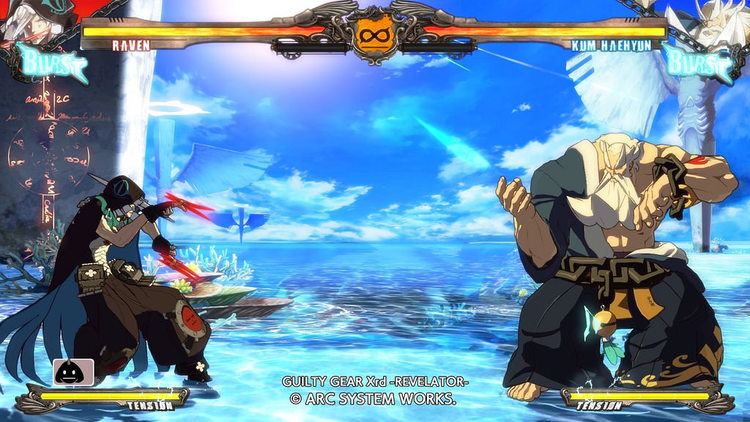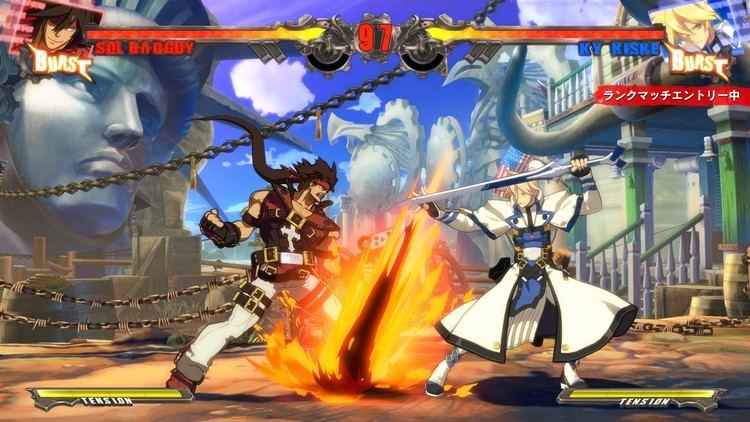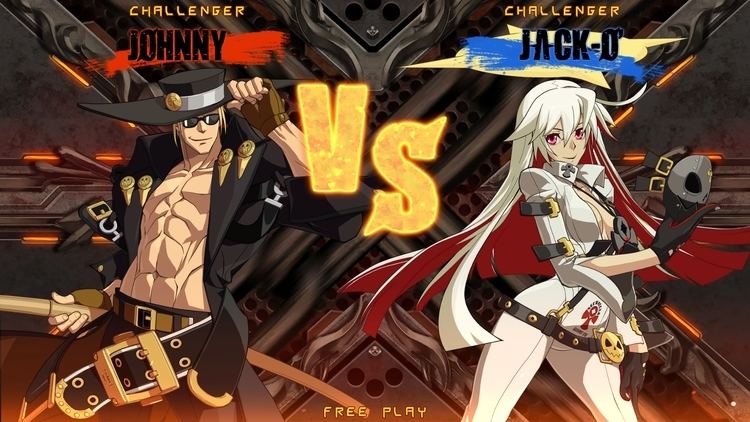Designer Daisuke Ishiwatari Genre Fighting game | ||
 | ||
Publishers Arc System WorksAksys GamesPQubeSegaSammy Entertainment (formerly)Kiss Ltd. (formerly) First release Guilty GearMay 14, 1998 Latest release Guilty Gear Xrd -Revelator-June 10, 2016 Developers Arc System Works, Capcom, Sega Sammy Holdings, Sammy Corporation, Majesco, Studio XELFLEX, Team Neo Blood Games Guilty Gear Xrd: Revelator, Guilty Gear Xrd, Guilty Gear 2: Overture, Guilty Gear Judgment, Guilty Gear Dust Strikers | ||
The evolution of guilty gear 1998 to 2016
Guilty Gear (ギルティギア, Giruti Gia) is a series of competitive fighting games by Arc System Works and designed by artist Daisuke Ishiwatari. The first game in the series was published in 1998, and spawned several sequels. It was also adapted to other media such as manga and drama CD. Guilty Gear has generally received praise from video game reviewers for its graphics, soundtrack, and mainly for its characters. Another fighting game franchise by Arc System Works, BlazBlue, is considered a spiritual successor of the series.
Contents
- The evolution of guilty gear 1998 to 2016
- Guilty gear xrd sign faust stimulating fists of annihilation on all characters 1080p60hd
- Gameplay
- Playable characters
- Media
- Music
- Reception and legacy
- References

Guilty gear xrd sign faust stimulating fists of annihilation on all characters 1080p60hd
Gameplay

Guilty Gear consists primarily of one-on-one competitive battles. Players are tasked with depleting their opponent's life gauge by utilizing attacks unique to each playable character. In the case of timed matches, the player with the most remaining life when time runs out is the victor of that round.

Guilty Gear Isuka prominently allowed up to four simultaneous players in battle, as well as the option to divide the characters into teams. It also eschewed the typical multiple-round format in favor of each player having a limited stock of "souls". Depleting a player's life gauge decreased their stock of souls and temporarily incapacitated them, and each remaining soul allowed a player to return to battle with a full life gauge. They would be defeated for the rest of the match if their life gauge and souls were both exhausted. These features have not returned for subsequent games.

Each game in the series includes a "Tension Gauge" that fills as the player performs offensive maneuvers, such as approaching the opponent or attacking them. Portions of the Tension Gauge can be expended to perform various techniques. Each character has at least one Overdrive, special attacks that can deal extensive damage to an opponent or bolster aspects of the user, like speed or attack power. "Faultless Defense" allows players to prevent "tick damage", damage received from normally guarding against special attacks, at the expense of the Tension Gauge. Guilty Gear X and later titles introduced more advanced techniques involving the Tension Gauge, such as the "Roman Cancel", allowing players to immediately stop the remaining animation of an attack, and "Dead Angle Attacks", counterattacks performed while a player is guarding.
The Tension Gauge is also tied in with the usage of "instant kill" techniques (一撃必殺技, ichigeki hissatsu waza), high-risk attacks that are difficult to connect with but instantly inflict death on the opponent regardless of the amount of life remaining. In Guilty Gear, these attacks ended the entire match if they successfully hit the opponent, but this was toned down in later games by ending the round instead. Failing to connect with the technique penalizes the user by removing the Tension Gauge and its related uses for the rest of the round.
Guilty Gear X2 introduced a "Burst Gauge" that slowly fills during the progression of a match. When completely filled, players can perform a "Psyche Burst" in an attempt to quickly stop an opponent's offense, even knocking back the opponent if they are close enough. This mechanic has also appeared in some form in other Arc System Works games, such as BlazBlue and Persona 4 Arena, as well as other fighting games such as Skullgirls.
Many characters also feature their own unique mechanics that differentiate them from each other. For example, Zato-1 utilizes a shadow-like symbiotic creature named Eddie that is able to detach itself and be controlled separately for a period of time, allowing complex tandem attacks between the two. Venom can set out weaponized billiard balls on screen that can be projected in various directions depending on how the player strikes them with certain attacks. Johnny carries a limited set of coins that can be thrown at the opponent. Though the coins themselves deal little damage, each successive hit strengthens his "Mist Finer" technique to incredibly powerful levels.
Playable characters
^a Playable in the Slash update onward, Guilty Gear XX Slash.
^b Only playable in the PlayStation 2 version.
^c Only in Guilty Gear Petit 2.
^d Only in the update version, Guilty Gear X Plus.
^e Only playable in the update/sequel version, Guilty Gear Xrd -REVELATOR-
^f Kliff and Justice were balanced for tournament play in the Guilty Gear XX Accent Core Plus R update.
Media
In addition to the Guilty Gear video game series, other products were also released. Two novelizations of Guilty Gear X were written by Norimitsu Kaihō, illustrated by the own Daisuke Ishiwatari, and published by Enterbrain: Lightning the Argent (白銀の迅雷, Shirogane no Jinrai), and The Butterfly and Her (胡蝶と疾風, Kochō to Hayate), on January 20, 2001 and on August 24, 2002. A manga titled Guilty Gear Xtra (ギルティギアXTRA), a collaboration among Daisuke Ishiwatari, Norimitsu Kaihō, and Akihito Sumii, was serialized in Kodansha's Magazine Z on September 22, 2003. Studio DNA and Enterbrain also published comics anthologies. Several drama CDs were published; Scitron released a series of two drama CDs—Guilty Gear X Vol. 1 and Vol. 2—between October 24, and November 24, 2001, and two series of drama CDs based on Guilty Gear X2 were released by Team Entertainment: Red and Black—a series— were released in 2003 between July 16, and August 20. Another series of drama CDs, Night of Knives, was published in three volumes between October 20 and December 22, 2004. Also action figures, guidebooks, and a trading card game series based on Guilty Gear were released. On February 11, 2017, Arc System Works announced a collaboration with Tecmo Koei's Team Ninja to release Arc System Works Costume Set consisting the costumes of some characters from BlazBlue and Guilty Gear series on March 2017 for Dead or Alive 5: Last Round.
Music
The Guilty Gear PlayStation disc has a hidden song that can be played on a computer by opening the sound file "OBJ_" and skipping to track 2. The song repeats after 1:13 and loops a few times.
Reception and legacy
The Guilty Gear series is considered a cult classic among video game fans. The series has often been remarked upon for its visual elements, fighting engine, soundtrack, and the variety of designs of the characters and attacks. X's Dreamcast version has the highest score of the series as compiled by review aggregator GameRankings (89.33%), while X2 for PlayStation 2 occupies that position according to the other major aggregator, Metacritic (87). On the other hand, the lowest score is given to Guilty Gear 2: Overture from both GameRankings (58.19%) and Metacritic (56/100).
Guilty Gear is considered by several sources to be the greatest 2D fighting game. GameSpot said that "Guilty Gear is one of the few non-Capcom or SNK 2D fighters to make any sort of impact on the genre", while Eurogamer stated: "If 2D beat-em-ups are moving toward extinction, they really are ending on a high note with stuff like this." Its sequels were also well received. GameSpy said "Guilty Gear X is hands-down the best 2D fighting game to date", and Guilty Gear X2 was described by About.com as "easily the best 2D fighter to come around in a long time."
In 2012, Complex ranked Guilty Gear at number 47 on the list of the best video game franchises, commenting: "Where other fighters were moving toward realism and more down to Earth physics and combos, Guilty Gear was content to turn those notions on their head, paving the way for the more chaotic fighters we're seeing today." Yahoo! Voices' editor S.W. Hampson included Guilty Gear among the 10 best fighting game franchises of all time, praising the series's evolution along the years, the "distinctive visual flair" of its 2D sprites, and the "well-defined story lines", adding "its identity is among the most unique in the world of beat-'em-ups."
BlazBlue: Calamity Trigger, another fighting game developed by Arc System Works, is often referred to as a spiritual successor of the Guilty Gear series.
